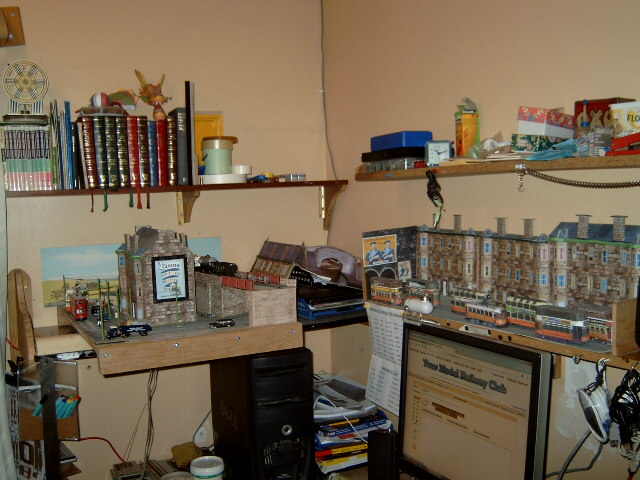Gradients
Posted
#165382
(In Topic #9453)
Full Member
I'm about to start building a baseboard for "Glebe Street" my 00 gauge Glasgow tram layout. It's intended to be wall mounted and run along the wall behind my computer/modeling area in my alleged office as this is the only space available. I intend to make it 12" wide on the long run and, as you look at it, have a 2' x 3' extension on the left and a 2'x2'6" extension on the right. This will give me a run of 9'11" with the left end extending out 3' and the right end 2'6" with a 5'11" central street scene run.


As you can see I already have shelves on each wall. The right side being 1.5" lower top to top than the centre and the left side being 3" lower.
It would be relatively easy to raise both ends up to reach the centre but more in keeping with a street tramway to have a hill on at least one side, if not both.
The advice I need is what sort of gradient is the maximum I can expect to get a model to climb, or, how do I work this out and how do I get a gentle enough start to the slope to let a tram with only 2mm ground clearance to enter and leave the hill?
Yes I will be doing the traditional trial and error but it will be nice to have somewhere to start.
Regards
Jim
Because, except in some unfortunate circumstances, trains did not run on town centre streets
Posted
Full Member
My guess is that the 1 in 40 maximum (on the straight) for model railways would be pretty shallow for trams. Given that they won't be pulling anything, I think you could get away with a much steeper climb.
I read somewhere that the first few inches should be half the intended grade to get an easy transition at each end. At that, I doubt you'd have any "bump" as the tram enters the grade if you aimed for an entry and exit of around 1 in 80.
I'd experiment at around 1 in 30 and see how they climb.
'Petermac
Posted
Full Member
Well to be honest I only know of a few truly awesome gradients for street trams. There was Dog Kennel Hill in London where the Board of Trade would only allow one car at a time on the gradient and so it had twin tracks, Leeds had Stanningley Lane where you come out from under a railway arch and do a 90 degree turn, Glasgow (actually Clydebank) had Kilbowie Road (mainly 1:7 but 1:OH MY GOD in places) where only single deckers were allowed and, in a class all of its own, Bradford which has so many hills it’s easier to describe the flat bits and St Enochs Road which is a totally exposed embankment with a 1:8 gradient and so windswept that cars had to lower all the windows when negotiating it. Windage was also the reason that Bradford cars were not allowed to have enclosed balconies.
As far as Bradford goes there was only 2 overturnings one was at the foot of Church Bank (1:10.5) and the other at the junction of Great Horton Rd and Horton Grange Rd.

However fascinating this is it does not help with the actual construction details such as how to start the gradient. Still, most towns and cities followed the medieval layout established round a river or stream and were fairly flat so it may only be a case of adjusting the two side shelf heights ( I need to keep the centre section at the original height to clear various appliances) to fit and ignoring any mismatch as prototypical roadway variation.
Regards
Jim
Because, except in some unfortunate circumstances, trains did not run on town centre streets
Posted
Full Member
I have been quite surprised at the gradients that tram actually climb. As a kid I regularly travelled up a hill not knowing until years later that it was the place where one of the worst tram accidents for fatal accidents took place, Crabble Hill between Dover and River. Interestingly the primary school I went to, River, was right beside the tram route and as a kid I can never recall it being mentioned.
Subsequently living in Bradford I realised the sort of hills that trams climbed.
David
freelance model railways and tramways
index02
index02
Posted
Full Member
As I said earlier, the advantage of trams over trains is that they didn't pull anything behind them so all the weight was down onto the driving bogies.
I wonder what a model tram would actually climb sensibly …………:roll::roll::roll: ? I suspect we'd all get quite a surprise. ;-)
'Petermac
1 guest and 0 members have just viewed this.

